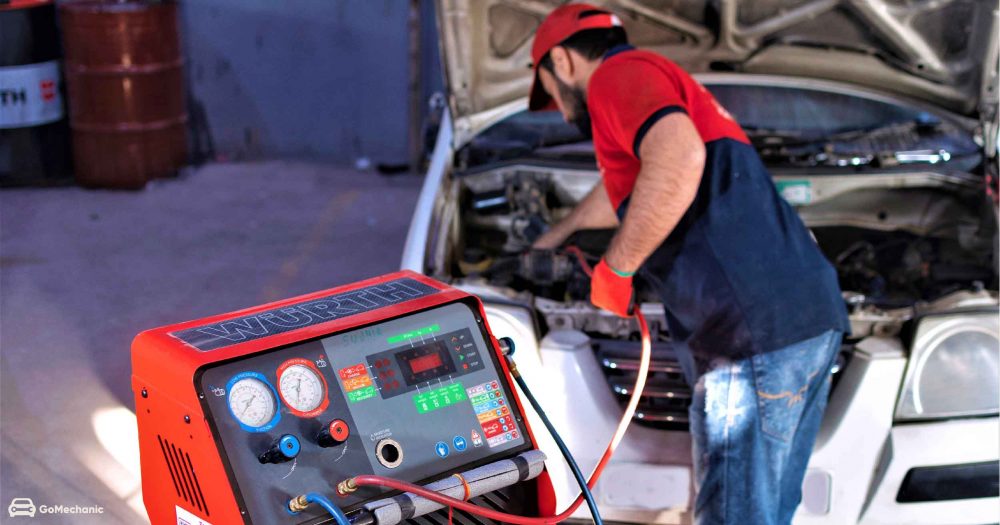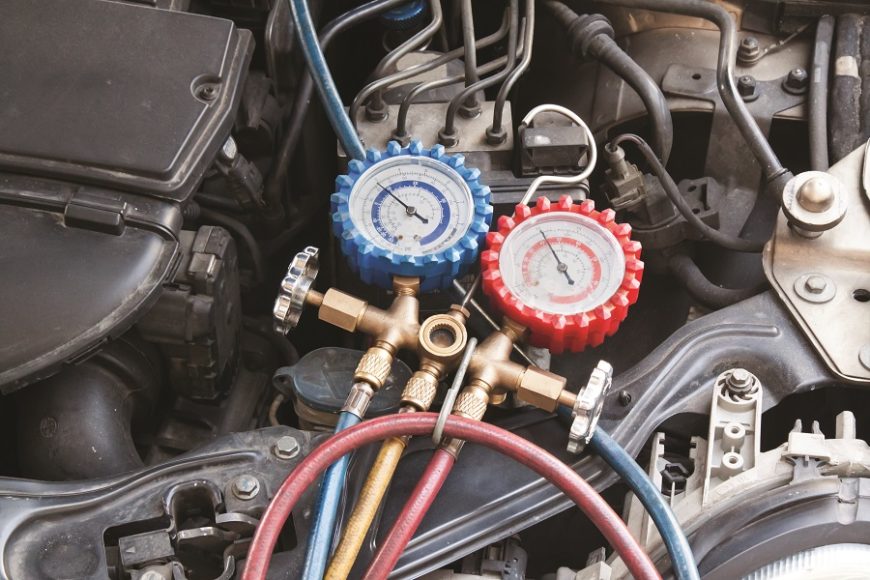Summer is here and boy it’s here to stay. Be your daily office commute or a weekend getaway, travelling without AC is going to be dreadful. Given that the temperature inside the car cabin can rise up to 60°C, checking up on your car AC should be your top priority. There can be a host of issues creeping up like low cooling, odour, failed compressor and many others. Although regular AC maintenance should be a ritual, it is generally prescribed to get a full car AC service every year to keep the cooling at maximum efficiency.

In this blog post, we are going to elaborate on what goes inside AC servicing. Learn more on vital AC components, common AC issues and how you can easily maintain your car air conditioning at home! Read more.
How a Car AC Works
Let’s get some insight into what makes a car AC function – the components. Starting with the-
-
Compressor
As the name suggests, is responsible for compressing the refrigerant. The compressor works like a pump that pressurises the refrigerant and passes it on to the evaporator. The drive-belt drives the compressor. It also powers the power steering, water pump etc.
-
Refrigerant
The refrigerant is a fluid that is contained within the coils of a car AC system that makes the whole cooling thing possible. The most common refrigerant used in Car AC is the R134-a, also known as Tetrafluoroethane. Before 1993, the most widely used refrigerant was the R-12 a.k.a Freon. They, however, quickly replaced Freon since it harmed the environment.
-
Condenser
A condenser is a mesh of coils. They arrange these coils in a zig-zag pattern to easily remove the heat from the compressed gas. It acts as a heat exchanger which cools the refrigerant by changing its state from gas to liquid.
-
Evaporator
The evaporator is quite opposite of a condenser. It converts the liquid refrigerant back to its gaseous state. It simultaneously dissipates the heat and further cools it down. The evaporator is located inside the car. The manufacturers typically place it behind the dashboard.
-
Expansion Valve
The expansion valve works in tandem with the evaporator. It controls the pressure of the AC refrigerant through the AC system.
-
Dryer/Accumulator
The dryer unit contains a desiccant. It is responsible for pulling away moisture that can seep into the AC system and the cabin.
Up next: Top 10 Reasons that your Car AC isn’t Cooling Enough
Turn on the blower, push the AC button and enjoy the cool and comfortable cabin.
Well, there is more to it than that. When you switch on the AC, the compressor kicks in using some power from the engine. It then compresses the refrigerant present in the AC system causing it to liquefy.
The liquified refrigerant then travels to the condenser. This then pulls the heat out using fresh air assisted by a fan. Afterwards, the refrigerant flows through the expansion valve where the pressure is checked and regulated.
Further down the line, the dryer pulls out moisture or impurities from the system. The now cool and clean gas is passed through the evaporator fins where a blower fan pushes the cold air out of the dashboard vents. The refrigerant is then pulled back to the compressor where the cycle starts all over again.
Download the GoMechanic App Now!

Car AC Service: A to Z

When you take your car for a car AC service, the technician starts by checking the cabin temperature while operating the AC. It should be approximately 5°C-10°C. They would then proceed to check the level of the refrigerant present in the system.
When the refrigerant level drops it affects the AC’s ability to cool. In fact, one of the most common reasons why the air-conditioning isn’t cooling your car properly is this. Using a pressure gauge and a precision AC gas recharging machine, they flush the refrigerant out and tops it up to the recommended level.
While working on this, they also check if there is any possible leak or crack in the AC line and hoses. The technician may use a UV dye to better pinpoint a possible leak in the system.
Then comes the compressor, which is the most expensive component in a car AC system. It is what powers everything. If the compressor malfunctions, the whole AC system will fail. So, if there is a visible leak it could be because of a bad seal and bearing. The compressor making whirring noise while operating could point to the same thing. The best way to keep a compressor working is to get it checked out and serviced every year. Also, make sure to get them to replace the compressor oil.
The condenser, which resides in front of the engine is checked for bent/damaged fins or a clogged line. A condenser becomes clogged due to leaves, dust and debris build-up. It can also really bring down the cooling efficiency of the AC. If such is the case, the condenser is washed with mild water pressure so as to not bend the fins.
Furthermore, they also see if the dryer is properly functioning. They also do a final inspection of the evaporator for any moisture build-up. The moisture build-up is not good news. This is because the water content can seep into vital electrical components under the dashboard.
Finally, they clean the cabin filter or the HVAC filter (heating, ventilation, air conditioning) located under the glove box. After every 15,000km, the filter is replaced.
5 Common Car AC Problems (with Troubleshooting)
-
Car AC not cooling enough
This can be due to low refrigerant level or a failed compressor, which can be quite expensive to fix. Another reason for this is, something as easy as a clogged condenser. If the condenser becomes clogged it decreases the surface area of the coil and this results in less cooling.
-
Bad odour from the AC
The reports of this car AC problem are common. A faint or strong foul smell would point to mould/mildew or moisture formation in the AC filter. Cleaning or replacing the filter usually solves the problem.
But if you smell “rotten eggs” while operating the AC, there can be pest invasion or a dead animal somewhere in the system. We strictly recommend you should get a professional handle this.
-
Loud whirring noise
Loud high-pitched whirring noise while operating the AC can be due to a shot compressor bearing (in case the noise is coming from the engine bay). But, if the noise is coming from inside the cabin, the blower fan assembly needs a repair or a replacement.
-
Water seeping inside the cabin
When the refrigerant flows through the evaporator, it becomes condensed. This forms water. If the drain tube which directs the water to the outside becomes blocked, you may notice water inside the car cabin.
-
Engine overheating
Just like the steering or the water pump, the compressor uses some power from the engine (using the serpentine belt). The clutch on the compressor can seize causing the compressor to put an unnecessary load. This eventually overheats the engine.
Read more: 8 Signs Of A Failing Car AC | Car Air Conditioner Diagnosis
Car AC Maintenance: DIY

Here are a few steps you can take to better maintain your car AC, that too at home!
-
Wipe the vents
Did you know, all that dust on the AC vent can eventually accumulate. It can then clog-up the cooling coil causing a drop in cooling. Using a brush or a sponge and gently clean the AC vent every once in a while.
-
Clean the cabin filter
The cabin filter or the HVAC filter located behind the glove box can get dirty. The filter can clog due to dust and debris from the outside. Like we said before, mould and mildew can also form. This can lead to foul odour while the AC operates. You can easily service the AC filter using a brush. You can clean the fins with this. Spray a deodoriser before installation for better results.
-
Clean the condenser
The condenser is located behind the front bumper of the car. It is made of aluminium fins and line which take in the fresh air. The fan helps the condenser to cool the flowing refrigerant. Make a habit of hosing down the condenser with low-pressure water. This would dislodge the stuck leaves, debris or dust that can potentially affect the cooling of the AC.
The servicing of the car’s air conditioning is unavoidable. A responsible car owner should make sure to service their car AC every year for maximum cooling efficiency.
So, what are you waiting for? Bring your car down to the nearest GoMechanic workshop for a full car AC service at the best price in your city.
Read: How Does The Car AC Work? Automotive Air Conditioning Explained







Great , thanks for information.
Thanks for sharing this blog post it’s very helpful to me
Thanks for sharing the topic and its very helpful to me
very interesting, good job and thanks for sharing such a good blog.
I am really very much worried about bad smell from my ac vent, I found the reason of that from your blog.
Glad you fond our blog informative!
Stay pinned for more.
really great post.. thanks for sharing this with all
Car Ac is common issue and important also.This is very effective and useful post. Thank you for the post.
Hi Diane
Thanks for the appreciation! Stay pinned for more 🙂
Very useful information. My AC was releasing more dust thanks for sharing how to maintain AC.
Thanks for sharing this blog post it’s very helpful to me ac service in Jaipur
Hello, This is an amazing article. Provides proper information about ac repairing in home as well as car.
Great tips to remember while repairing AC. Loved your articles please keep posting. Thankyou
Thanks for sharing this informative post.